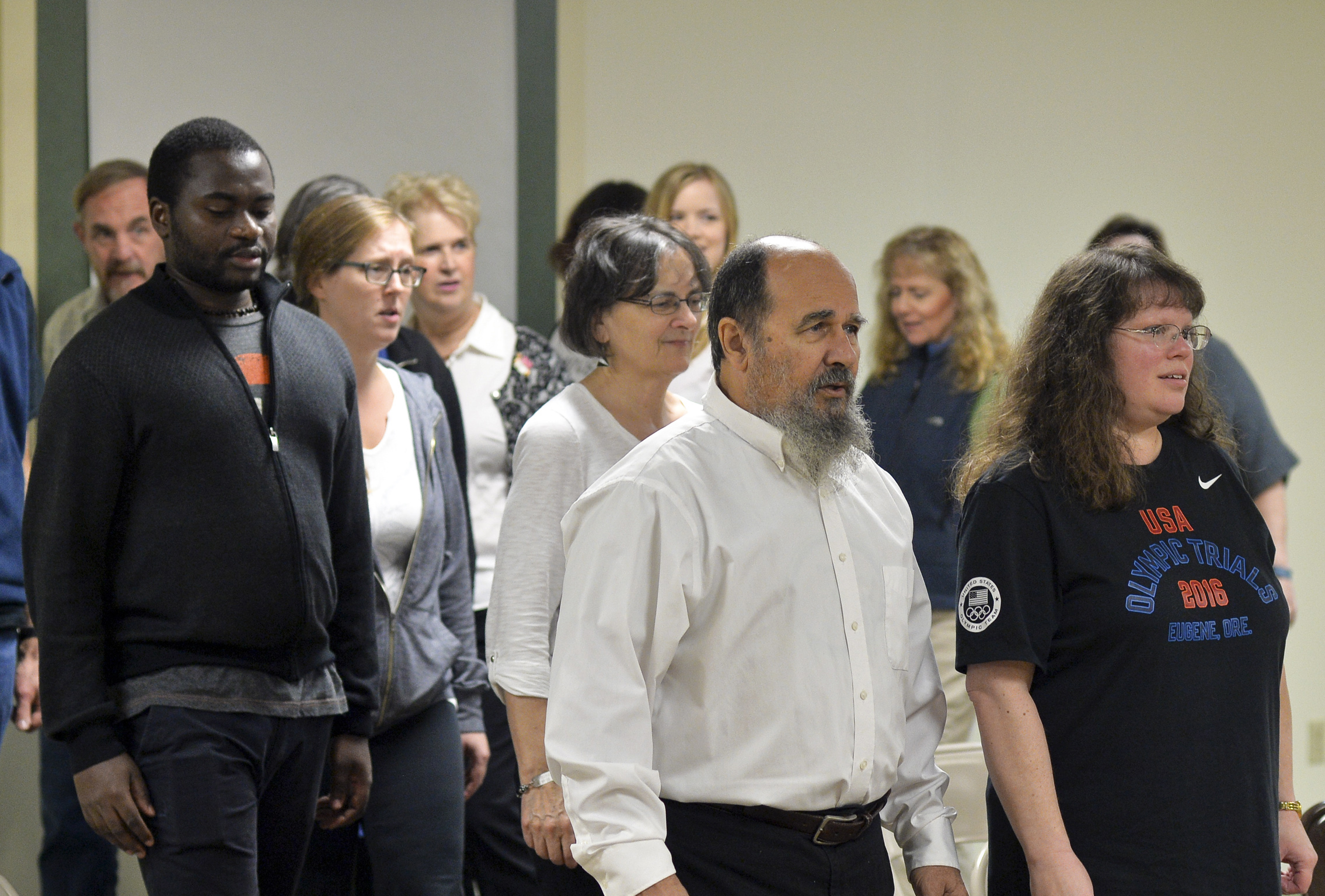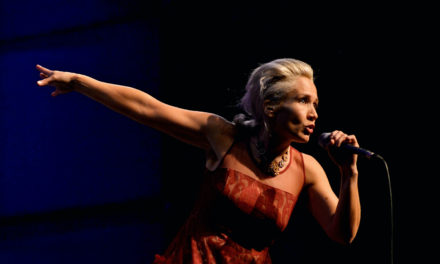This new version adds eight new songs to the program: Why Did I Choose You in the first set, plus I’m The Greatest Star, and a completely new third set of songs. “I’ve also extended the time period and will be focusing on Barbra’s television specials from 1965 to 1968,” Andress said. “The last set is from those specials — some absolutely gorgeous and a few others bordering on absurd.” For dyed-in-the-wool Streisand fans, those include: Gotta Move; My Coloring Book; A Good Man Is Hard to Find; Marty, The Martian; He Touched Me, “and I finish the show with a song that Barbra sang later in her life, so very honestly, about her developed fears when performing for live audiences,” Andress said. “The song is called, Being Good.”
My Name is Barbra, The Making of a Funny Girl
When: 7:30 p.m. Saturday, Feb. 29; and 3 p.m. on Sunday, March 1
Where: Jaqua Concert Hall, The Shedd Institute for the Arts, 868 High St., Eugene
Creative team: Stage director and choreographer, Richard Jessup; musicians
Vicki Brabham, Matt Taylor, Glenn Griffith, Devin Perez, Nathan Waddell, Don
Elkington and Michael Radliff.
Tickets: $10-$32, available at The Shedd ticket office, 541-434-7000, or online at TheShedd.org
2019 Eugene Scene story about Shirley Andress’ Streisand show, Bon Soir
By Randi Bjornstad
Performing a solo show of music made popular by Barbra Streisand may be a little bit out of the ordinary for The Shedd Institute for the Arts, but it’s a natural for Eugene vocalist Shirley Andress, who takes to the stage there often.
“It is something of a departure for The Shedd, but it’s been a wish of mine for decades, ever since my 9-year-old self became mesmerized by Barbra Streisand in Funny Girl,” Andress said. “From the time I was in the fourth grade through the eighth grade, I listened to nothing but Streisand.”
Three years ago, after she did her solo show, Fever: Remember Peggy Lee, at The Shedd, she asked Jim Ralph, The Shedd’s executive director and guru of the American Songbook, “ ‘How about if I do a show about Barbra Streisand?’ ” Andress recalled with a laugh. “And he thought about it and then said, ’Nah, I don’t think so.’ ”
A year or so later, though, “He came to me and said, ‘You know, I may not be all that much of a fan of Streisand myself, but why don’t you go ahead?’, and that was enough for me,” Andress said.
For the past year, she’s been working on Bon Soir, featuring music Streisand sang from 1960 to 1964, from her earliest days singing in clubs to appearances on television to her starring role on Broadway in Funny Girl. The show will be onstage at The Shedd April 12 to 14.
“I think what captivated me about Barbra Streisand when I was a child was that when she sang something, I believed her,” Andress said. “Yes, of course she was dramatic, and grand, and had an extraordinary vocal range, but that’s not what I noticed. I noticed that she was driven by words, so I wasn’t necessarily attracted just to the sound but also the way it made me feel. I wanted to do that.”
She saved up her allowance and bought a Streisand album, “and I sat in the rocking chair and listened to it for hours and hours.”
Eventually, Andress expanded her musical interests into other genres, but she always hoped to come back to pay homage to her earliest idol.
“This project is really different from others that I’ve done — it really stretches me,” she said. “Barbra’s range is so unusual, it’s seamless and equally strong all the way through, from the G below middle C to a high G.”
She’s not going to try to sound like Streisand, “but I am going to try to phrase the songs the way she does, because that’s what gives them their meaning,” Andress said.
Streisand has been recognized — even criticized — throughout her career for her unusual nose, “but that’s what has made her so successful, because she is able to use its uniqueness all the way through her musical register,” she said.
“Ironically, especially when she got into movies, people would say she wasn’t pretty enough. They said the name Streisand was too Jewish — she should change it to Sands — and they said she should do something about her nose to make her prettier. But I think that would have changed her entire voice, and probably ruined it.
“Nowadays, different is good, but back then it wasn’t that way.”
The program for Bon Soir includes 23 songs, “and my goal was to sing in Barbra’s keys, and I only have changed three, and those only by a half-step,” Andress said. “That slight change on those three songs lets me get into my own resonating spaces, to be able to perform them the way I think I need to.”
She admits 23 songs “is a lot for one show — I don’t think even Barbra Streisand would want to do it.”
Andress chose Bon Soir as the title of her homage to Streisand because that was the name of the club in Greenwich Village in New York City where the star started her singing career.
“She made $108 a week, and she sang a set of seven songs every evening,” Andress said. “She got noticed for the Bon Soir gig because she was entering a talent contest at a different club every week and winning every time.”
Just two years later, Streisand was offered a contract for $15,000 a week, “but she had to decline because she was already in Funny Girl.”
Much as she has wanted to do this for years, putting the show together has been hard.
“This project has been so big, and being both art director and performer is really a lot of work,” Andress said. “On top of that, I’m also cast for two musicals in the fall. I keep telling everybody I might have to retire after all this.”
After all, she’s been in show biz for a long time.
“My parents said I was always a little performer — I sang and played piano,” she said. “After I discovered Barbra at age 9, at 10 I did a pantomime of her doing Secondhand Rose for a talent show at school. As a child, I was also in ballet. When I got to high school, I started acting, and I did musicals, but I didn’t really have voice or dance lessons until I was in college.”
Andress grew up in Pleasant Hill and majored in music education at the University of Oregon, “but I never taught in the school system — I substitute taught a bit, but I started my own voice studio.”
Her first foray onto the local stage was when Eugene impresario Ed Ragozzino was doing his elaborate musical theater productions, “and I got the role of Wendy in Peter Pan,” she said.
All in all, Andress is happy that she has been able to make her way on local stages.
“I got married when I was 21 and soon had kids,” she said. “I often wonder what would have happened if I had done things differently, but I am a believer that you end up where you are supposed to be.
“I feel I have been able to have a great career right here at home.”
2019 review of Bon Soir
By Daniel Buckwalter
She was a gum-chewing, Brooklyn-born Jewish kid, a brash and determined 17-year-old who also was filled with anxiety, mostly about her looks.
Yet Barbara Streisand, from the moment of her very first professional audition in 1960, intrigued, then captivated, then grew an adoring crowd that lasts to this day. Her vocal range was immense. Her personality was (and still is) equal to her talent because of the honesty she has displayed about her anxieties. Streisand is an icon.
To match this talent and presence is not easy, but Eugene resident Shirley Andress captures it with exquisite touch this weekend at the Jaqua Concert Hall at The Shedd.
Andress touches on the classics of Streisand’s career start in a three-day run at The Shedd of Shirley Andress: Bon Soir — Barbara Streisand, 1960-64. Andress’ own magical pipes and commanding presence on stage is a perfect vehicle to tell the rags-to-riches story of Streisand.
It’s a well-known story to many to fans of the singer, actress and movie producer. Streisand walks into an audition, all of 17, and startles everyone with her talent. She doesn’t get the job she is aiming for, but in four short years she rockets to stardom beyond compare.
There is, of course, the Bon Soir club in Manhattan, where she truly begins to find herself professionally, becoming at once the brash and daring performer with a touch of elegance that people will gravitate to. She is becoming the talk of the town.
From there Streisand will sing at the Blue Angel (for more than $1,000 per week), perform for a short time at a club in Detroit (where nightly steak dinners are written into her contract), come back to New York and by 1961 appear on the Jack Parr television show.
By the fall of 1963, Streisand makes her West Coast debut (the Coconut Grove and the Hollywood Bowl), and this is followed in 1964 by the role that defines her to many, as Fanny Brice in the stage production of Funny Girl. Streisand reprises the role in film in 1968.
It’s a four-year arc wonderfully sung and spoken of by Andress, who, since singing as a child, has pointed to Streisand as her professional North Star. Andress is vibrant throughout the two hours, singing 23 (yes, 23) pieces that Streisand performed in the 1960-64 period.
This is not to say it is easy for Andress, though. It takes athleticism. Twice on Saturday night Andress commented on how difficult it was to find space to breathe inside a piece of music. This drew chuckles from the audience. It was an adoring crowd on this night that gave her a well-deserved standing ovation.
Andress is powerful in her renditions of Streisand’s music. She is backed up expertly by a seven-piece band led by pianist Vicki Brabham. Andress and Brabham have known each other since they were teenagers, and their trust in each other is absolute.








